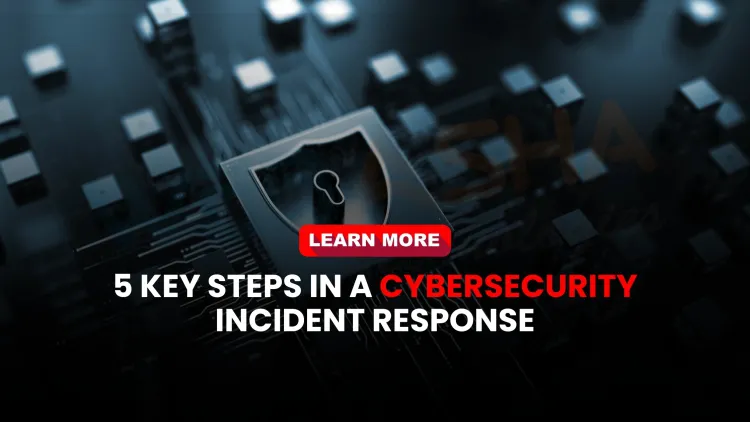What are the 5 key steps in a cybersecurity incident response plan and how do they help mitigate and recover from attacks?
An effective cybersecurity incident response plan includes five key steps: Preparation, Identification, Containment, Eradication & Recovery, and Lessons Learned. These steps ensure organizations are ready before an attack, can detect threats early, stop them from spreading, recover operations securely, and learn from the incident. This structured approach minimizes downtime, financial loss, and reputational damage while improving future resilience.

Table of Contents
- What Is a Cyber Security Incident Response Plan (IRP)?
- Why Incident Response Is Crucial?
- 5 Critical Steps of an Effective Cyber Security Incident Response Plan
- Overview of the 5 Steps in Incident Response
- Real-World Example: SolarWinds Attack
- Conclusion
- Frequently Asked Questions (FAQs)
In today’s fast-evolving digital world, cyber attacks are no longer a matter of "if" but "when." Whether it’s ransomware, phishing, insider threats, or zero-day exploits, organizations must be prepared to respond swiftly. That’s where Cyber Security Incident Response comes in.
An effective incident response plan (IRP) allows businesses to detect, contain, and recover from cyber threats while minimizing damage. In this blog, we’ll explore the five key steps of an incident response strategy and how to apply them to stay resilient after a breach.
What Is a Cyber Security Incident Response Plan (IRP)?
A Cyber Security Incident Response Plan (IRP) is a structured framework for handling and managing a security incident or breach. The primary goal is to quickly identify threats, contain the damage, reduce recovery time, and limit the cost and reputational harm of cyberattacks.
An IRP is typically managed by a Computer Security Incident Response Team (CSIRT) or Security Operations Center (SOC). The plan outlines roles, responsibilities, and processes to ensure coordinated action during and after a security incident.
Why Incident Response Is Crucial
-
Reduces Downtime: Quicker detection and resolution mean operations resume faster.
-
Minimizes Financial Losses: Rapid containment prevents escalation and reduces cleanup costs.
-
Protects Reputation: A well-handled breach shows customers and partners that you’re responsible and proactive.
-
Ensures Compliance: Regulatory bodies (like GDPR, HIPAA, etc.) often require documented response processes.
-
Improves Future Defenses: Lessons learned can strengthen your security posture.
5 Critical Steps of an Effective Cyber Security Incident Response Plan
1. Preparation
This is the foundation of the entire response process. Preparation involves planning, training, and creating tools and procedures before an incident occurs.
Key Actions:
-
Define roles and responsibilities within your incident response team (IRT).
-
Document communication strategies (internal and external).
-
Set up and regularly update the IRP.
-
Conduct tabletop exercises and simulation drills.
-
Maintain up-to-date asset inventory and backups.
Tip: Use tools like SIEMs (e.g., Splunk, IBM QRadar) to monitor and detect anomalies in real-time.
2. Identification
This step focuses on recognizing potential security incidents. The goal is to detect malicious activity early to prevent spread and damage.
Key Actions:
-
Monitor systems continuously using intrusion detection/prevention systems (IDS/IPS).
-
Analyze logs, alerts, and reports to confirm unusual activity.
-
Identify which systems, data, or users are affected.
Example: Suspicious login attempts from a foreign IP could indicate a brute-force or credential stuffing attack.
3. Containment
Once an incident is confirmed, quick action is necessary to stop the attack and prevent it from spreading to other systems.
Key Actions:
-
Isolate affected machines or networks.
-
Disable compromised accounts or services.
-
Apply temporary firewall rules or access controls.
-
Create forensic images of impacted systems for investigation.
Short-term containment prevents escalation, while long-term containment ensures the attacker is fully blocked.
4. Eradication & Recovery
After containment, the next phase is to remove the root cause and restore systems to a secure state.
Key Actions:
-
Remove malware, unauthorized access, or rogue applications.
-
Patch vulnerabilities and update configurations.
-
Restore systems from clean backups.
-
Validate integrity and security of restored environments.
Ensure the threat is completely removed before restoring operations, or reinfection may occur.
5. Lessons Learned (Post-Incident Review)
The final step is about improvement. It involves reviewing the incident to identify what went right, what went wrong, and how to do better next time.
Key Actions:
-
Conduct a root cause analysis (RCA).
-
Document timeline and impact.
-
Update the incident response plan based on findings.
-
Train staff and adjust security controls accordingly.
This step transforms a security incident into a learning opportunity that strengthens overall resilience.
Overview of the 5 Steps in Incident Response
| Step | Objective | Example Activities |
|---|---|---|
| Preparation | Build readiness before an incident | Create IRP, assign team roles, conduct drills |
| Identification | Detect and confirm the incident | Monitor logs, alerts, suspicious behaviors |
| Containment | Limit impact and stop attack from spreading | Isolate systems, revoke access, temporary firewall adjustments |
| Eradication & Recovery | Remove threats and restore operations | Malware removal, patching, restoring from backup |
| Lessons Learned | Improve future response and update strategies | RCA, post-mortem review, plan updates |
Real-World Example: SolarWinds Attack
The 2020 SolarWinds breach demonstrated the importance of a robust IRP. The attackers inserted malicious code into software updates affecting thousands of organizations. Those with proactive monitoring, swift containment protocols, and recovery procedures were able to detect and limit the damage quickly.
Best Practices for Effective Incident Response
-
Keep your IRP updated with evolving threats.
-
Train your team regularly using realistic scenarios.
-
Automate detection and containment where possible.
-
Establish secure and clear communication during crises.
-
Regularly test your backup and restoration capabilities.
Conclusion
Cybersecurity incidents are inevitable, but the damage they cause doesn’t have to be. A well-prepared, tested, and continuously improved incident response plan is key to protecting your organization. By following the 5-step approach—Preparation, Identification, Containment, Eradication & Recovery, and Lessons Learned—you can navigate any cyber threat with confidence and resilience.
FAQs
What is a cybersecurity incident response plan?
A cybersecurity incident response plan is a documented strategy outlining how an organization will detect, respond to, and recover from cyber threats and breaches.
Why is incident response important in cybersecurity?
It helps minimize damage, reduce recovery time and costs, protect sensitive data, and comply with legal and regulatory standards.
What are the five steps of incident response?
The five steps are: Preparation, Identification, Containment, Eradication & Recovery, and Lessons Learned.
How does preparation help in incident response?
Preparation builds readiness by defining roles, establishing tools, and training the response team to act quickly during a breach.
What is the identification phase in cybersecurity?
It involves detecting unusual or suspicious activity, confirming incidents, and determining their scope and impact.
How does containment limit the damage of an attack?
Containment stops the threat from spreading by isolating affected systems and limiting attacker access.
What is the difference between short-term and long-term containment?
Short-term containment is immediate isolation; long-term involves ensuring the attacker can’t regain access later.
What is eradication in the incident response process?
Eradication involves removing malware, closing vulnerabilities, and eliminating the root cause of the incident.
What steps are involved in recovery after a cyberattack?
Restoring systems from clean backups, verifying system integrity, and bringing operations back online securely.
What happens during the lessons learned phase?
The team analyzes what went wrong, documents findings, and updates the response plan to prevent future incidents.
How often should incident response plans be tested?
They should be reviewed and tested at least annually, or after major incidents, software changes, or organizational shifts.
Who manages the incident response plan?
Typically, a dedicated CSIRT (Computer Security Incident Response Team) or the Security Operations Center (SOC).
Can small businesses benefit from incident response planning?
Yes, even small organizations can reduce risk and recovery time with a well-prepared response plan.
What tools assist in cybersecurity incident detection?
SIEM tools like Splunk, IBM QRadar, and endpoint detection solutions help monitor and detect threats.
How do backups support incident recovery?
Backups allow organizations to restore clean data and systems after malware infections or data loss.
What is a root cause analysis in cybersecurity?
It’s an investigation into the origin of the breach to understand how it occurred and how to prevent it.
Are there legal requirements for incident response?
Many regulations (GDPR, HIPAA, PCI DSS) require organizations to have a documented incident response process.
How can incident response reduce reputational damage?
Quick, transparent action reassures stakeholders and shows that the organization takes security seriously.
What is the role of communication in incident response?
Effective internal and external communication prevents confusion and ensures coordinated response actions.
How do you train staff for incident response?
Run regular drills, tabletop exercises, and provide cybersecurity awareness training.
How fast should an incident be responded to?
The faster the better—early response can prevent data exfiltration, ransomware deployment, and widespread impact.
What is the impact of delayed response in cyber incidents?
Delays can lead to data theft, operational shutdowns, higher financial loss, and compliance violations.
Can incident response plans prevent future attacks?
While not preventative, they improve detection, mitigation, and preparedness for future incidents.
What’s the difference between detection and identification?
Detection flags anomalies, while identification confirms whether those anomalies are actual security incidents.
How do you isolate an infected system?
Disconnect it from the network physically or via remote management tools to stop threat spread.
What is the importance of forensic imaging during containment?
It preserves evidence for analysis, legal compliance, and understanding attacker techniques.
Is ransomware handled differently in IRP?
Yes, ransomware response may involve encryption analysis, ransom negotiations, and legal considerations.
How do organizations update their IRP after an incident?
Through post-incident reviews, documentation, and process updates based on what was learned.
What is incident escalation?
It refers to notifying higher authorities or involving third parties when a breach exceeds internal handling capacity.
Should you involve law enforcement during a cyberattack?
Yes, especially for major breaches involving data theft, extortion, or nation-state actors.
How do cloud environments affect incident response?
Cloud adds complexity; you must coordinate with providers and ensure logging and access control are in place.














![Top 10 Ethical Hackers in the World [2025]](https://www.webasha.com/blog/uploads/images/202408/image_100x75_66c2f983c207b.webp)








